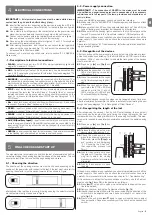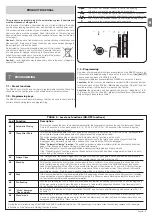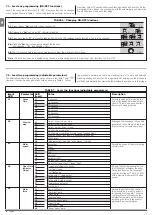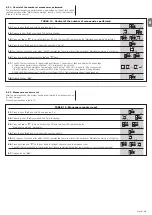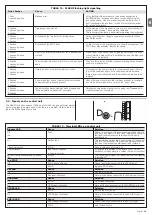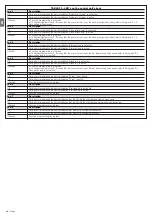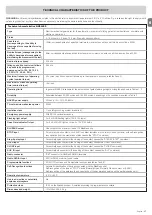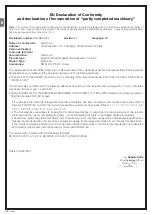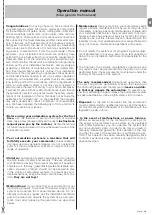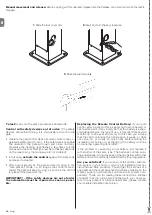
EN
English –
19
Operation manual
(to be given to the final user)
Congratulations
for having chosen a Nice product for
your automation system! Nice S.p.A. produces components
for the automation of gates, doors, rolling gates, roller shut-
ters and awnings: gearmotors, control units, radio controls,
flashing lights, photocells and miscellaneous accessories.
Nice uses only the finest materials and first-class workman-
ship. It focuses on the development of innovative solutions
designed to simplify the use of its equipment, dedicating
meticulous care to the study of its technical, aesthetic and
ergonomic characteristics: From the wide range of Nice
products, your installation technician will certainly have
selected the one best suited to your specific requirements.
However, Nice is not the producer of your automation sys-
tem, which is rather the result of a combination of operations
carried out by your installation technician, namely analysis,
evaluation, selection of materials and system implementa-
tion. Each automation system is unique. Your installation
technician is the only person who possesses the experience
and professionalism needed to set up a system capable of
satisfying your requirements, a system that is safe, reliable,
long lasting and built in accordance with the regulations in
force. An automation system is not only very convenient; it
also improves the level of security in your home. Moreover,
it will last for years with very little maintenance. Even though
the automation system you posses meets the safety require-
ments of the legislation in force, this does not exclude the
existence of a “residual risk”, i.e. the possibility that dangers
may arise, usually as a result of improper or unreasonable
use. We have prepared the following list of do’s and don’ts
to help you avoid any mishaps:
•
Before using your automation system for the first
time,
ask the installer to explain the origin of residual
risks; take a few minutes and read the users
instructions
manual given you by the in stal ler
. Retain the manual
for future use and deliver it to any subsequent owner of the
automation system.
•
Your automation system is a machine that will
fai thfully execute your commands;
unreasonable or
improper use may generate dangers: do not operate the
system if there are people, animals or objects within its
range of operation.
•
Children:
automation systems are designed to guaran-
tee high levels of safety and security. They are equipped
with detection devices that prevent movement if people or
objects are in the way, guaranteeing safe and reliable acti-
vation. However, children should not be allowed to play
in the vicinity of automated systems; to prevent any acci-
dental activations, keep all remote controls away from chil-
dren:
they are not toys!
•
Malfunctions:
If you notice that your automation is not
functioning properly, disconnect the power supply to the
system and operate the manual release device. Do not
attempt to make any repairs; call the installation technician
and in the meantime, operate the system like a non-auto-
matic door after releasing the gearmotor as described
below.
•
Maintenance:
Like any machine, your automation needs
regular periodic maintenance to ensure its long life and
total safety. Arrange a periodic maintenance schedule with
your installation technician. Nice recommends that main-
tenance checks be carried out every six months for normal
domestic use, but this interval may very depending on the
intensity of use. Only qualified personnel are authorised to
carry out checks, maintenance operations and repairs.
• Do not modify the system or its programming and adjust-
ment parameters in any way, even if you feel capable of
doing it: your installation technician is responsible for the
system.
• The final test, the periodic maintenance operations and
any repairs must be documented by the person who has
performed them; these documents must remain under the
custody of the owner of the system.
The only recommended
maintenance operations that
the user can perform periodically concern the cleaning of
the photocell glasses and the removal of
leaves and deb-
ris that may impede the au to mation.
To prevent any-
one from activating the gate release the automation system
(as described below). Use a slightly damp cloth to clean.
•
Disposal:
At the end of its useful life, the automation
must be dismantled by qualified personnel, and the materi-
als must be recycled or disposed of in compliance with the
legislation locally in force.
•
In the event of malfunctions or power failures.
While you are waiting for the technician to come (or for
the power to be restored if your system is not equipped
with buffer batteries), you can operate the system like
any non-automatic gate. In order to do this you need to
manually release the gearmotor (this operation is the only
one that the user of the automation is authorized to per-
form): This operation has been carefully designed by Nice
to make it extremely easy, without any need for tools or
physical exertion.
Summary of Contents for Naked Sliding NKSL400
Page 2: ......
Page 43: ...I 405 mm 131 mm 135 mm 1 3 4 5 b d c c h l b f m g i n e a E C F D C F A B 2...
Page 44: ...II b a b a c 5 mm 6 7 10 11 8 9...
Page 46: ...IV 14 15...
Page 48: ...VI 19 20 a b c d e...
Page 49: ...VII 21 22...
Page 50: ......
Page 51: ......

